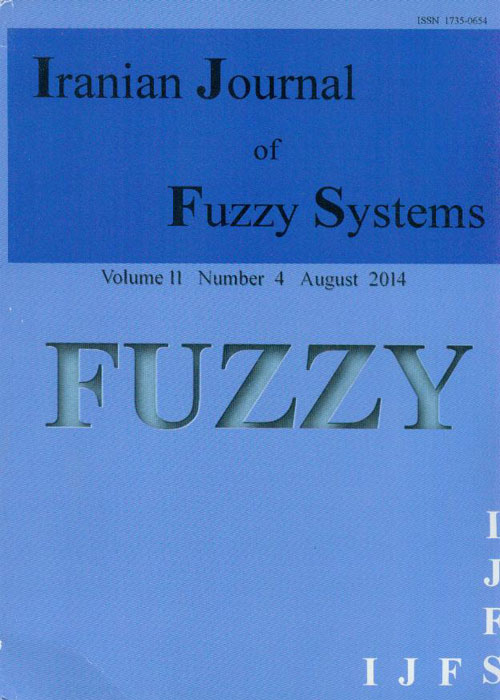فهرست مطالب

Iranian journal of fuzzy systems
Volume:11 Issue: 4, Aug2014
- 106 صفحه،
- تاریخ انتشار: 1393/06/15
- تعداد عناوین: 7
-
-
Page 1In this paper, global robust stability of stochastic impulsive recurrent neural networks with time-varying delays which are represented by the Takagi-Sugeno (T-S) fuzzy models is considered. A novel Linear Matrix Inequality (LMI)-based stability criterion is obtained by using Lyapunov functional theory to guarantee the asymptotic stability of uncertain fuzzy stochastic impulsive recurrent neural networks with time-varying delays. The results are related to the size of delay and impulses.Finally, numerical examples and simulations are given to demonstrate the correctness of the theoretical results.Keywords: Global asymptotic stability, Impulsive perturbations, Stochastic fuzzy recurrent neural networks, Time, varying delays
-
Page 15Let $(u_n)$ be a sequence of fuzzy numbers. We recover the slow oscillation of $(u_n)$ of fuzzy numbers from the Cesaro summability of its generator sequence and some additional conditions imposed on $(u_n)$. Further, fuzzy analogues of some well known classical Tauberian theorems for Cesaro summability method are established as particular cases.Keywords: Cesaro summability, Slow oscillation, Tauberian theorems, Sequences of fuzzy numbers
-
Page 23The aim of this paper is to establish a fuzzy version of the duality between domains and completely distributive lattices. All values are taken in a fixed frame $L$. A definition of (strongly) completely distributive $L$-ordered sets is introduced. The main result inthis paper is that the category of fuzzy domains is dually equivalent to the category of strongly completely distributive $L$-ordered sets. The results in this paper establish close connections among fuzzy-set approach of quantitative domains and fuzzy topology withmodified $L$-sober spaces and spatial $L$-frames as links. In addition, some mistakes in [K.R. Wagner, Liminf convergence in $Omega$-categories, Theoretical Computer Science 184 (1997) 61--104] are pointed out.Keywords: Fuzzy dcpo, Fuzzy domain, Fuzzy Scott topology, (Spatial) $L$, frame, $L$, frame homomorphism, (Strongly) Completely distributive $L$, ordered set, Modified $L$, sober
-
Page 45In this paper, we apply the homotopy analysis method (HAM) for solving fuzzy linear systems and present the necessary and sufficient conditions for the convergence of series solution obtained via the HAM. Also, we present a new criterion for choosing a proper value of convergence-control parameter $hbar$ when the HAM is applied to linear system of equations. Comparisons are made between the results of the HAM and several well-known numerical algorithms such as Jacobi method (JM), Gauss-Seidel method (GSM), successive over relaxation method (SOR), Adomian decomposition method (ADM) and homotopy perturbation method (HPM).Keywords: Fuzzy linear system, Homotopy analysis method, Convergence, control parameter, Numerical algorithms
-
Page 61lthough fuzzy set theory and sheaf theory have been developed and studied independently, Ulrich Hohle shows that a large part of fuzzy set theory is in fact a subfield of sheaf theory. Many authors have studied mathematical structures, in particular, algebraic structures, in both categories of these generalized (multi)sets. Using Hohle's idea, we show that for a (universal) algebra $A$, the set of fuzzy algebras over $A$ and the set of subalgebras of the constant sheaf of algebras over $A$ are order isomorphic. Then, among other things, we study the category of fuzzy acts over a fuzzy semigroup, so to say, with its universal algebraic as well as classic algebraic definitions.Keywords: Fuzzy algebra, Fuzzy act, Sheaf
-
Page 75The sequential $p$-convergence in a fuzzy metric space, in the sense of George and Veeramani, was introduced by D. Mihet as a weaker concept than convergence. Here we introduce a stronger concept called $s$-convergence, and we characterize those fuzzy metric spaces in which convergent sequences are $s$-convergent. In such a case $M$ is called an $s$-fuzzy metric. If $(N_M,ast)$ is a fuzzy metric on $X$ where $N_M(x,y)=bigwedge{M(x,y,t):t>0}$ then it is proved that the topologies deduced from $M$ and $N_M$ coincide if and only if $M$ is an $s$-fuzzy metric.Keywords: Fuzzy metric space, principal fuzzy metric, $p$, convergence
-
Page 87In this paper we establish a Tauberian condition under which convergence follows from Holder summability of sequences of fuzzy numbers.Keywords: Holder means, Slow oscillation, Tauberian theorems, Fuzzy numbers

